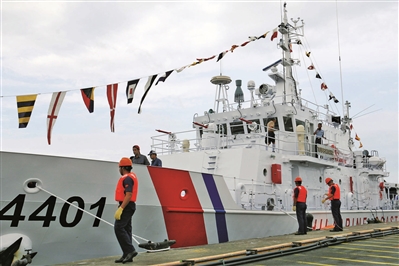
Japan delivers maritime patrol boats to the Philippine Coast Guard. (File photo)
By Wen Weiru
According to Japanese media reporting, the Japanese government held a National Security Council meeting in early April and established a new foreign military assistance mechanism, which will be taken as the basis for providing weapons, military supplies and other military assistance to specific countries.
It is reported that this new mechanism named Official Security Assistance (OSA)aims to assist certain developing countries to strengthen military capabilities by providing funds, weapons and equipment, as well as the construction of military airports, ports and other infrastructure.
After World War II, the Japanese government learnt from the experience of Western countries and built the Official Development Assistance (ODA) mechanism to mainly assist developing countries in economics, politics and public livelihood. This mechanism is regarded as an important method to deal with post-war relations, revitalize the economy and improve the national image for the country. And Japan managed to ease tensions with Southeast Asian countries.
Different from ODA which is confined to non-military fields, this new mechanism will focus on the military fields. In 2017, Japan revised the Self-Defense Forces Act to allow transferring second-handed equipment of the force to other countries for free or at a low price. Later, Japan provided, in batches, 12 patrol boats to the Philippines and another 9 patrol boats to Vietnam free of charge.
It is learned that this year Japan is planning to provide the Philippines, Malaysia, Bangladesh and Fiji with radar and satellite communication systems for surveillance of territorial watersand airspace. In addition, it also plans to offer communications systems to multiple other Indo-Pacific countries in 2023.
The formation of this new military assistance mechanism symbolizes that Japan has blatantly broken the ban on international assistance for military purposes, and established an institutional military assistance system at scale. It is believed that Japan intends to achieve double purposes through the Official Security Assistance mechanism.
On the one hand, Japan aims to activate demands by assistance and accelerate weapon export. Since breaking the restraints of the Three Principles on Arms Exports in 2014, Japan has been acting frequently in the international arms market. It expects to hasten personnel training, equipment maintenance and upgrade, and other practical demands through continuous military arms assistance to certain countries, and gather overseas feedback on Japanese weapons to visualize purchase demands. It can also append some military trade conditions in tandem with military assistance.
On the other hand, Japan aims to exchange recognition by assistance and accelerate expanding regional military influences. With the institutionalized military mechanism, the Japanese government will allocate a certain amount of budget annually, and choose assistance targets from so-called applicant countries "with common value", in order to woo certain countries and pave the way for future joint military exercises, military exchanges and endorsement of bilateral documents such as Reciprocal Access Agreement. This will help Japan achieve the purposes of increase military presense, expanding military influence and enhancing military discourse power in certain regions.
Japan has intended to become a "normal country" in politics and military for long. The formation of this new military assistance mechanism is another move of Japan after it lifted the ban on the right of collective self-defense, sent troops overseas based on constitutional interpretation, revised its security strategy and defense strategy, substantially increased military expenditures, and developed offensive weapons.
Recently, Japan has been strengthening its military presence in Indo-Pacific on the pretext of maintaining "freedom, democracy and rule of law". In late March, Japanese Prime Minister Fumio Kishida announced a new plan with the vision of a "free and open Indo-Pacific" during his visit to India, and promised to invest 75 billion US dollars by 2030 to support the infrastructure construction of developing countries in this region.
Japan is expanding its influence in Indo-Pacific by economic means under the banner of a "free and open Indo-Pacific", and striving for weapon export under the guise of "military assistance", which will jeopardize the stability of the region.













